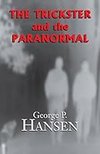
Saved by baja and
The Trickster and the Paranormal

Saved by baja and
That process gives an identity. In making a distinction, some representation is required, whether simply mental, or more concretely as with gesture, speech, artistic portrayal, or writing. For instance, naming both makes a distinction and creates a representation. Naming, classification, and abstraction are processes of boundary drawing; they are
... See moreHoaxes are liminal productions. They lower the statuses of the victims, and loss of status is one of the defining characteristics of limi-nal conditions. Marginality is another trickster quality, and hoaxes help marginalize not only the victims but the whole field of ufology. Hoaxes assist the rationalization and disenchantment of the world. They
... See moreUFOs are liminal and anti-structural; they are found betwixt and between the heavens and the earth (a binary opposition). They have properties in common with angels, spirits, fairies, and demons. These are all interstitial, and when one enters this realm, one must tread cautiously because other binary oppositions can become blurred. The
... See moreThe evidence indicates that UFOs are not “nuts and bolts” craft driven by “flesh and blood” humanoid aliens. They are something quite different. The direct sightings are not the only, or even the most important, aspect; social and cultural circumstances surrounding UFO events must be considered as part of the phenomena. One should examine effects
... See morePostmodernist theories suggest that the world can be understood as though one was reading a book or text. This metaphor (i.e., the world is text), allows one to ask new questions that would not be generated by traditional scientific paradigms. Reading requires interpretation, and postmodernist and post-structuralist theories emphasize the variety
... See moreUFO and cattle mutilation research efforts are extremely marginal, and intelligence agencies can easily penetrate and disrupt them with little hindrance or consequence. The few investigators who venture into these areas are particularly vulnerable to manipulation. They cannot pursue their studies in a manner typical of normal science; intelligence
... See moreHistorically, many groups that attempted to engage paranormal phenomena became unstable. There is little reason to think that secret government projects would escape that fate. They too are probably prone to paranoia and conspiracy theorizing. Because of the secrecy surrounding their work, and the importance of it, they could be susceptible to
... See moreWhen an investigator studies something that can be intentionally deceitful, and has intelligence-gathering capabilities of its own, the usual paradigms of science are inadequate. New frameworks and perspectives are needed.
Psi phenomena, including synchronicities, are somewhat “ideo-plastic,” that is, they respond to, and are shaped by, the ideas, beliefs, and anxieties of the observers—a fact demonstrated in both laboratory and field studies. The phenomena also display a measure of independent intelligence.